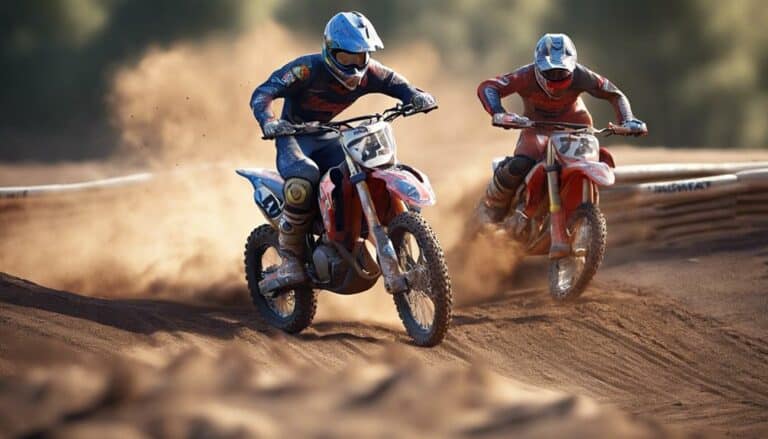You might not realize that the way you approach corners on a motocross track versus a trail ride can notably differ in technique and execution. Understanding the distinct nuances between these two disciplines can enhance your riding skills and overall performance.
The key variances in cornering between motocross and trail riding go beyond just speed and terrain; they encompass critical aspects such as bike setup, body positioning, and throttle control. By grasping these differences, you can adapt your cornering strategy effectively to excel in both motocross and trail riding scenarios.
Key Takeaways
- Motocross focuses on aggressive braking and leaning for speed, while trail riding emphasizes precise line selection and weight shifting.
- In motocross, speed and control balance is crucial for high-speed corners, whereas trail riding requires precise speed management for technical terrain.
- Body positioning differs: motocross leans for control, trail riding prioritizes stability with an upright position and weight centered.
- Equipment and setup vary, with motocross bikes requiring versatile setups and trail bikes needing adjustability for different terrains.
Motocross Cornering Techniques Overview
When negotiating corners in motocross, riders employ a combination of aggressive braking, precise line selection, and strategic throttle control to maintain momentum and swiftly maneuver through turns. The key to mastering motocross cornering lies in understanding how body position influences traction and control. By leaning the bike aggressively into corners and shifting their body weight to the inside of the turn, riders optimize their center of gravity and improve overall stability. This technique allows for better control over the bike's trajectory, enhancing the rider's ability to navigate tight corners with confidence.
Moreover, in motocross, throttle control plays an essential role in cornering. Riders modulate the throttle to power through the turn and accelerate out of it efficiently. By balancing the use of brakes and throttle, riders can effectively manage speed while maintaining traction on varying track surfaces. This balance between aggressive braking, precise throttle control, and strategic body positioning is what sets skilled motocross riders apart in cornering technique.
Trail Riding Cornering Fundamentals
In trail riding, mastering cornering fundamentals is essential for maneuvering diverse terrain with control and precision. Trail riders must focus on several key aspects to navigate corners effectively:
- Choosing the Right Line: Evaluating the terrain ahead to select the best path through the corner is important for maintaining speed and control.
- Adjusting Speed: Modulating your velocity before entering a corner allows for smoother changes and better traction on varying surfaces.
- Body Positioning: Shifting your weight towards the inside of the turn helps in balancing the bike and maintaining stability through the corner.
- Throttle Control: Properly applying the throttle during cornering assists in managing traction and power delivery, enabling a smoother exit from the turn.
Body Positioning Variances and Impact
Body positioning discrepancies between motocross and trail riding greatly influence the handling dynamics and maneuvering capabilities riders exhibit when negotiating corners. In motocross, aggressive body positioning is key to achieving lean angles that maximize speed and control through corners. Motocross riders actively shift their weight to the outside of the turn to counterbalance the bike's lean, allowing for sharper and faster cornering. This technique enhances maneuverability but requires a high level of skill and balance.
Conversely, trail riders maintain a more upright body position to prioritize stability and control over varied terrain during cornering. By keeping their weight centered over the bike, trail riders can navigate obstacles and maintain traction through corners, ensuring a smoother and safer ride. While this upright posture may sacrifice some speed compared to motocross techniques, it offers increased stability and confidence in unpredictable trail conditions. The distinct body positioning strategies in motocross and trail riding significantly impact cornering technique, influencing lean angles, stability, and maneuverability in diverse riding environments.
Speed Management in Different Environments
Speed management plays a critical role in both motocross and trail riding, dictating the approach riders take in traversing diverse environments and obstacles. When considering speed management in different environments, here are some key points to keep in mind:
- In motocross, speed management is essential for maneuvering high-speed corners and jumps on the track. Riders need to balance speed with control to maintain a competitive edge.
- Trail riding requires precise speed management for technical terrain and obstacles like rocks, roots, and tight corners. Adjusting speed is important for overcoming these challenges safely.
- Motocross riders focus on maintaining consistent speed for rhythm sections and keeping up momentum through corners to optimize lap times.
- Trail riders must adapt their speed for challenging uphill and downhill sections where traction and control are paramount. Controlled acceleration is key to negotiating these obstacles effectively.
Understanding how to manage speed effectively is crucial for mastering both motocross and trail riding, ensuring a safe and successful ride.
Applying Techniques for Improved Performance
To enhance your performance on the track or trail, implementing specialized cornering techniques is essential for achieving excellent results.
In motocross, where speed is important, mastering aggressive cornering techniques like the 'blast in, turn blast out' method is key. Motocross bikes demand aggressive throttle inputs and precise body positioning to power through corners at high speeds effectively.
On the other hand, trail bikes excel in technical trail cornering by offering a smoother approach that prioritizes maintaining momentum and control. Gearing adjustments play a critical role in optimizing cornering performance for both motocross and trail bikes. Motocross bikes require versatile setups to adapt to different track conditions, while trail bikes need adjustability to tackle varying terrains effectively.
Conclusion
To sum up, mastering the distinct cornering techniques of motocross and trail riding is essential for success on the track or trail. By understanding the nuances of body positioning, speed management, and bike handling, you can navigate corners with precision and confidence.
Remember, just as a painter uses different brush strokes for different masterpieces, a rider must adapt their techniques to the specific demands of each discipline like a skilled artist creating a masterpiece on two wheels.

